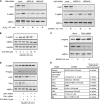IRE1-dependent activation of AMPK in response to nitric oxide
- PMID: 21896783
- PMCID: PMC3209336
- DOI: 10.1128/MCB.05668-11
IRE1-dependent activation of AMPK in response to nitric oxide
Abstract
While there can be detrimental consequences of nitric oxide production at pathological concentrations, eukaryotic cells have evolved protective mechanisms to defend themselves against this damage. The unfolded-protein response (UPR), activated by misfolded proteins and oxidative stress, is one adaptive mechanism that is employed to protect cells from stress. Nitric oxide is a potent activator of AMP-activated protein kinase (AMPK), and AMPK participates in the cellular defense against nitric oxide-mediated damage in pancreatic β-cells. In this study, the mechanism of AMPK activation by nitric oxide was explored. The known AMPK kinases LKB1, CaMKK, and TAK1 are not required for the activation of AMPK by nitric oxide. Instead, this activation is dependent on the endoplasmic reticulum (ER) stress-activated protein IRE1. Nitric oxide-induced AMPK phosphorylation and subsequent signaling to AMPK substrates, including Raptor, acetyl coenzyme A carboxylase, and PGC-1α, is attenuated in IRE1α-deficient cells. The endoribonuclease activity of IRE1 appears to be required for AMPK activation in response to nitric oxide. In addition to nitric oxide, stimulation of IRE1 endoribonuclease activity with the flavonol quercetin leads to IRE1-dependent AMPK activation. These findings indicate that the RNase activity of IRE1 participates in AMPK activation and subsequent signaling through multiple AMPK-dependent pathways in response to nitrosative stress.
Figures







Similar articles
-
eNOS activation mediated by AMPK after stimulation of endothelial cells with histamine or thrombin is dependent on LKB1.Biochim Biophys Acta. 2011 Feb;1813(2):322-31. doi: 10.1016/j.bbamcr.2010.12.001. Epub 2010 Dec 9. Biochim Biophys Acta. 2011. PMID: 21145922
-
The GST-BHMT assay reveals a distinct mechanism underlying proteasome inhibition-induced macroautophagy in mammalian cells.Autophagy. 2015;11(5):812-32. doi: 10.1080/15548627.2015.1034402. Autophagy. 2015. PMID: 25984893 Free PMC article.
-
TAK1 activates AMPK-dependent cytoprotective autophagy in TRAIL-treated epithelial cells.EMBO J. 2009 Mar 18;28(6):677-85. doi: 10.1038/emboj.2009.8. Epub 2009 Feb 5. EMBO J. 2009. PMID: 19197243 Free PMC article.
-
AMP-activated protein kinase in skeletal muscle: from structure and localization to its role as a master regulator of cellular metabolism.Cell Mol Life Sci. 2008 Nov;65(23):3737-55. doi: 10.1007/s00018-008-8244-6. Cell Mol Life Sci. 2008. PMID: 18810325 Free PMC article. Review.
-
Molecular signal networks and regulating mechanisms of the unfolded protein response.J Zhejiang Univ Sci B. 2017 Jan.;18(1):1-14. doi: 10.1631/jzus.B1600043. J Zhejiang Univ Sci B. 2017. PMID: 28070992 Free PMC article. Review.
Cited by
-
Cytokine-mediated β-cell damage in PARP-1-deficient islets.Am J Physiol Endocrinol Metab. 2012 Jul 15;303(2):E172-9. doi: 10.1152/ajpendo.00055.2012. Epub 2012 Apr 24. Am J Physiol Endocrinol Metab. 2012. PMID: 22535743 Free PMC article.
-
Nitric Oxide Suppresses β-Cell Apoptosis by Inhibiting the DNA Damage Response.Mol Cell Biol. 2016 Jul 14;36(15):2067-77. doi: 10.1128/MCB.00262-16. Print 2016 Aug 1. Mol Cell Biol. 2016. PMID: 27185882 Free PMC article.
-
Fumagillin prodrug nanotherapy suppresses macrophage inflammatory response via endothelial nitric oxide.ACS Nano. 2014 Jul 22;8(7):7305-17. doi: 10.1021/nn502372n. Epub 2014 Jun 24. ACS Nano. 2014. PMID: 24941020 Free PMC article.
-
Nitric Oxide Induces a Janus Kinase-1-Dependent Inflammatory Response in Primary Murine Astrocytes.ASN Neuro. 2021 Jan-Dec;13:17590914211033650. doi: 10.1177/17590914211033650. ASN Neuro. 2021. PMID: 34498493 Free PMC article.
-
FicD regulates adaptation to the unfolded protein response in the murine liver.Biochimie. 2024 Oct;225:114-124. doi: 10.1016/j.biochi.2024.05.012. Epub 2024 May 11. Biochimie. 2024. PMID: 38740171 Free PMC article.
References
-
- Ahn J., Lee H., Kim S., Park J., Ha T. 2008. The anti-obesity effect of quercetin is mediated by the AMPK and MAPK signaling pathways. Biochem. Biophys. Res. Commun. 373:545–549 - PubMed
-
- Almeida A., Moncada S., Bolaños J. 2004. Nitric oxide switches on glycolysis through the AMP protein kinase and 6-phosphofructo-2-kinase pathway. Nat. Cell Biol. 6:45–51 - PubMed
-
- Arnush M., Scarim A., Heitmeier M., Kelly C., Corbett J. 1998. Potential role of resident islet macrophage activation in the initiation of autoimmune diabetes. J. Immunol. 160:2684–2691 - PubMed
-
- Bhaskar P. T., Hay N. 2007. The two TORCs and Akt. Dev. Cell 12:487–502 - PubMed
-
- Calabrese V., et al. 2009. Nitric oxide in cell survival: a janus molecule. Antioxid. Redox. Signal. 11:2717–2739 - PubMed
Publication types
MeSH terms
Substances
Grants and funding
LinkOut - more resources
Full Text Sources
Molecular Biology Databases
Miscellaneous
